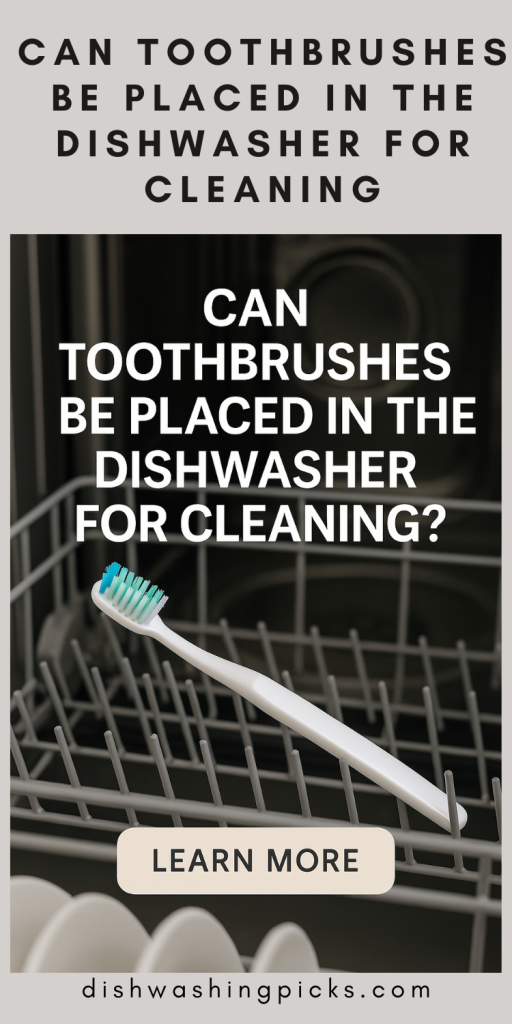Alright, let’s set the scene. You’re standing in your bathroom, toothbrush in hand, giving it that suspicious side-eye. Maybe it’s looking a little… grimy. Maybe you dropped it (no judgment), or maybe you’re just on a serious cleaning spree. Then the thought hits you:
“Wait a second… can I just toss this in the dishwasher?”
I mean, you clean your forks in there, right? Your cups, your spoons, your baby’s pacifiers—why not a toothbrush? Seems like a no-brainer. But hold on, let’s not go tossing bristles into hot jets just yet.
We’re about to break this whole thing down—whether it’s safe, smart, and actually effective to use your dishwasher as a toothbrush spa.
So grab a snack (or a toothbrush if you’re feeling inspired), and let’s answer the question that’s been sitting in the back of your mind every time you glance at that toothbrush holder.
Why Would Anyone Even Do That?
First off, fair question. Why would someone think to throw a toothbrush in the dishwasher?
Well, for one thing, it’s easy. Dishwashers are the lazy person’s cleaning dream. Load it up, press a button, walk away like a domestic wizard. And with all the talk about germs and bacteria hanging out on toothbrushes (yes, especially if you keep yours near the toilet—don’t shoot the messenger), it makes sense people want to keep things as sanitized as possible.
Plus, we’re all about multi-tasking these days. If your dishes get a high-heat, germ-killing rinse, why not your toothbrush?
But here’s the million-dollar question: just because you can, does that mean you should?
Let’s talk about what really happens when your toothbrush goes through a dishwasher cycle—materials, heat, hygiene, and all that good stuff—in the next section.
What Happens When You Put a Toothbrush in the Dishwasher?
So, you’ve decided to live on the edge. You open the dishwasher, toss in your toothbrush like it’s just another spoon, close the door, and press start. What now?
Well, here’s the deal: dishwashers aren’t exactly gentle. They’re hot, they’re steamy, and they blast your stuff with high-pressure water like it just insulted their mother. And toothbrushes? They weren’t exactly made for that kind of abuse.
Let’s break it down a bit:
1. Heat and Plastic – Not Always a Love Story
Most toothbrushes—especially the regular ol’ manual kind—are made of plastic. Throw them in a dishwasher that reaches temperatures of 140–160°F (60–70°C), and guess what? That plastic can warp. The handle might bend, and those nice, straight bristles? Say goodbye.
Imagine trying to brush your teeth with something that now looks like it went through a rock concert mosh pit. Not cute.
2. Bristles Can Break Down
Even if your toothbrush survives the cycle physically, its effectiveness might not. Those soft, flexible bristles that are designed to be gentle on your gums? They’re not huge fans of hot water and aggressive spinning arms. Repeated washes can make them fray faster than normal—or flatten out like they just gave up on life.
So yeah… technically, it comes out cleaner. But is it still good for your teeth? That’s debatable.
3. Electric Toothbrush Heads? Definitely a No-Go
Now if you’re rocking an electric toothbrush, pause right here. Do not throw that whole thing in the dishwasher. The internal parts (aka the stuff that makes it buzz) don’t do well with water, steam, or heat. Even removable heads can be sensitive.
If you put the entire unit in there? You’re basically giving your toothbrush a farewell party.
Should You Actually Do It? (And What Are the Alternatives?)
Okay, we’ve established that your toothbrush might survive a dishwasher cycle—but it could come out looking like it had a rough night. So, here’s the real question:
Is it really worth the risk just to save a little time?
Let’s weigh the pros and cons.
✅ The “Pros” (if you can call them that):
- It will get cleaned—heat and hot water do kill a fair amount of bacteria.
- Convenient—if you’re already running the dishwasher, you’re just tossing in one more item.
- No scrubbing needed—zero elbow grease involved.
But now for the other side…
❌ The (Much Longer) Cons:
- Damage risk is real: bent handles, misshaped bristles, and reduced effectiveness.
- Not designed for it: toothbrushes weren’t built to survive a dishwasher’s wrath.
- Electric toothbrush users? Definitely not dishwasher-safe.
- Doesn’t disinfect everything: a dishwasher might kill some bacteria, but it’s not a hospital-grade sterilizer.
So if you’re thinking, “Okay, okay. Maybe the dishwasher isn’t the move. But how should I clean my toothbrush then?” — great question!
Let’s go over a few easy, toothbrush-friendly alternatives:
🌀 Better Ways to Clean Your Toothbrush
1. Rinse it thoroughly after each use.
Sounds simple, but it works. Use hot water, and make sure to rinse away any leftover toothpaste and gunk from the bristles.
2. Let it air-dry upright.
Don’t trap it in a case or lay it flat on the counter—bacteria love damp, dark places. Standing upright in an open space is best.
3. Soak it in mouthwash (occasionally).
Want a little extra germ-fighting action? Soak the head in antibacterial mouthwash for a few minutes. Not every day—just once a week is plenty.
4. Try a UV sanitizer.
Feeling fancy? There are toothbrush sanitizers out there that use UV light to zap germs. No heat, no warping, no drama.
5. Replace it regularly.
Even if it’s sparkling clean, a toothbrush isn’t forever. The American Dental Association recommends swapping it out every 3–4 months—or sooner if the bristles are frayed.
Final Tip: Treat Your Toothbrush Like a Mini Tool for Self-Care
Think about it—this little plastic hero goes into your mouth twice a day, every day. It deserves a little TLC, right? Keep it clean, keep it fresh, and it’ll do the same for you.
And hey—next time you’re deep cleaning your kitchen and your toothbrush catches your eye, just remember: not everything belongs in the dishwasher.
(But if you do try it anyway… at least you’ll know what you’re getting into!)

